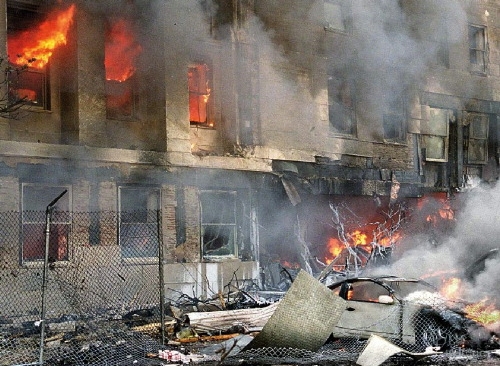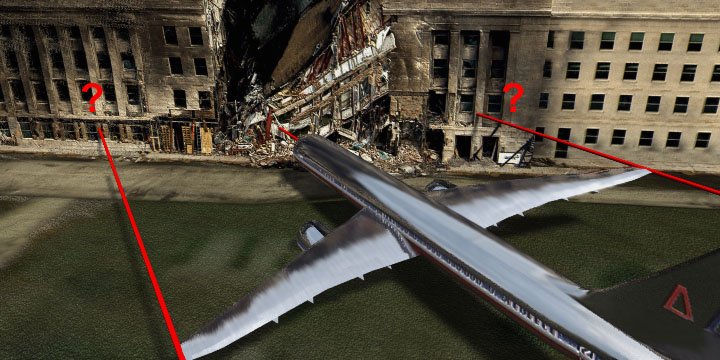
“When you eliminate the impossible, whatever remains — however improbable — must be the truth.” – Sherlock Holmes
September 26, 2010
By Craig McKee
I’m not in the habit of quoting fictional characters, but these words (actually written by Sir Arthur Conan Doyle) are so perfect when challenging assumptions about what happened with Flight 77 and the Pentagon on Sept. 11.
Unfortunately, many people approach things the other way around. They imagine that alternative scenarios are too far-fetched to be possible – so we have to stick to the official story. What I choose to do is to show what’s impossible and see what remains. That means focusing on the evidence. On facts.
In my last post, I took a look at some of the most obvious contradictions in the Pentagon crash. The biggest, of course, is the fact that the plane doesn’t fit in the hole at the supposed impact point, which was less than 20 feet across (there was first floor damage on either side of the hole that was much wider, but it was still not nearly a wide enough opening accommodate the wings. You can see part of the hole in the photo above).
And then there’s the wings. University of Waterloo mathematics PhD A.K. Dewdney and aerospace engineer Jerry Longspaugh wrote an analysis of the wing dilemma called “The Missing Wings” for the web site physics911.net.
In this essay, they look at what might have happened to the wings, giving the official version the benefit of the doubt. They quickly rule out the possibility that the wings were taken away by cleanup crews because the clean-up didn’t begin till much later. Something would have been visible in the photographs taken right after the crash.
The Department of Defense claimed that the wings “telescoped” into the body of the plane. This seems beyond bizarre, and Dewdney and Longspaugh challenge it, saying: “If you fixed a Boeing 757 firmly to a given piece of ground, then used a team of bulldozers to push the wings into the body, the wings would, merely fold up like an accordion or crumple and bend.”
They also shoot down the idea that the wings could have been blown into little pieces by the explosion of the fuel tanks. Because most of the fuel is stored under the fuselage, the body of the plane entering the hole in the wall would have led to the explosion taking place primarily inside the building, while the wings would have remained outside.
This is especially true of the left wing, which would have been far removed from the fire. Keep in mind that the plane allegedly came in at a 45-degree angle to the building. So that left wing would have well away from flames.
Could the wings have been folded against the side of the plane and been dragged through the hole? This is the key argument to refute, I feel. Given the small hole in the Pentagon wall, it would seem that the “folding” hypothesis would be the only possible one – if one wants to stick to the idea that it was a 757 that hit the building.
Here’s what they wrote:
“Try folding any material, say a piece of cardboard, by applying its edge (not its surface) to a tabletop. Folding horizontally is not an option, since all the spars would be lined up in opposing (momentarily) the folding force. Being locally rigid, the spars would simply snap within milliseconds of the impact against a support column that did not yield to their impact; they would fail as soon as the force of impact exceeded the elastic limit of the material. If they did not fail, and if the support columns did not give way, the only remaining possibility would be for the aircraft to remain almost entirely outside of the Pentagon.”
So they’re saying that rather than “folding in,” the wings would have broken off once they came into contact with the wall. Something had to give, the wall or the wing.
These experts say the left wing would have to have struck a column just to the left of the entry hole. “Since the column did not fail, the wing must have…and the entire weight of the wing still, traveling at 500-plus miles per hour, would have produced a bending force that was entirely concentrated on the point of contact of the wing with the support column. This would have snapped all three spars instantly.”
How do we know this did not happen? No wing pieces outside the building.
The essay by Dewdney and Longspaugh goes into a number of other areas, including the supposed aircraft parts that were found at the crash scene (most who have examined the photos of these parts have concluded that they are too small to be from a 757). They also look at what else might have hit the building, pointing to an F-16 fighter or other military jet as being the most likely possibilities.
But whatever it was, their methodical analysis of the wing question is enough on its own to disprove the Flight 77 myth. And if that’s a lie, what makes you believe the rest of the story?

flippin’ hell
I’d love it if you could elaborate on that thought a bit.
Yes, spot the vanishing one-hundred ton plane. It is almost as bad as the latest nonsense about the boogey-man, ghost, Bin-Lid. Anyway, onward to Libya, Pakistan, then Iran…PNAC!!
Thank god for Russia! that’s is all I can say.
ever consider the fact that the plane may have come in diagonally? With the wings up and down and not to the sides? If so, the tip of the lower wing would have broken it off and under the body of the plane (most likely) and the upper wing would have gone way of the fuselage after breaking backwards over the body of the plane… Just sayin.
Hahahahaha….Melinda,
That’s precious hon… in other words the wing facing the ground would have drug all the way across that pristine Pentagon lawn leaving no marks whatsoever, not to mention that huge engine not tilling a trough. Gotta say that is one of the best ones I’ve heard since, “Who’s on First” by Abbot and Costello…Lol
Too funny kiddo
\\][//